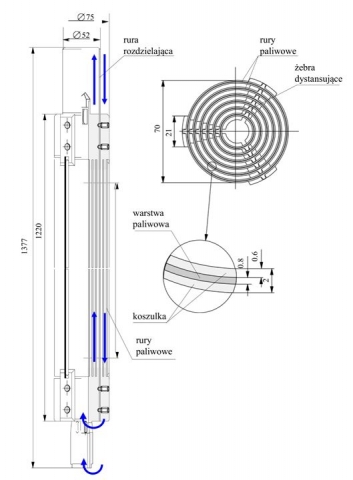Fuel of the MARIA reactor
The fuel element of the MARIA reactor consists of 6 (MR type) or 5 (MC type) concentric pipes 2 mm thick, separated by a 2.5 mm water gap. Water in the gaps between the fuel pipes plays a double role. First, it is a neutron moderator (slower) needed to slow down the fast neutrons generated during fission to thermal energies, at which subsequent fission of 235U nuclei takes place efficiently. Water also acts as a coolant, i. e. it is used to collect the heat generated in the fuel.
A single fuel element holds up to 485 grams of 235U. The fuel material used in the MARIA reactor is a dispersion of uranium oxide (Russian MR fuel) or uranium silicide (French MC fuel) in aluminum. The 0.8 mm thick fuel layer is placed between two layers, the so-called the fuel jacket, which prevents the release of fission products into the coolant. The fuel element of the MARIA reactor is shown in Figure 1. arrows indicate the direction of coolant flow.
The core of the MARIA reactor contains 6 to 7.5 kg of uranium-235 each time. This amount depends on the core configuration, fuel burnout and the current work program. The fuel elements are removed from the core after reaching a burnout of 235U within 40–60%. Further burning of the fuel is economically disadvantageous.
After the end of work in the core, the fuel is transferred to the storage basin, from where it is collected by the manufacturer after several years of cooling.













